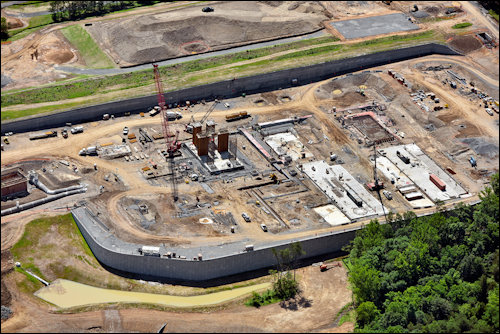by James A. Bacon
The 1,400-megawatt power plant proposed in Chesapeake by Matex Virginia Power last week is only one several natural gas-fired generating units under development by independent or out-of-state power producers. Panda Power Funds is constructing a 778-megawatt natural gas-fired plant in Loudoun County, while Southern Power has purchased 300 acres in a Pittsvylania County industrial park for yet another gas-fired power plant, reports the indefatigable Michael Martz in the Richmond Times-Dispatch this morning (no link).
News of those projects follows a June ruling by the State Corporation Commission approving a request by Doswell Limited Partnership to expand its combined-cycle gas complex in Hanover County by building two more gas turbines with a capacity of 340 megawatts.
It looks like Dominion Virginia Power isn’t the only power producer that sees a bright future for natural gas. Dominion opened a 1,400-megawatt plan in Brunswick County this summer, and it has started construction of an even bigger facility in nearby Greensville County. The utility’s 15-year Integrated Resources Plan envisions the need for yet another large facility in 2022 at an unidentified location. The company’s plans have come under fire by environmentalists who say that rapid advances in solar and wind technology may render the gas plants obsolete and uneconomical and saddle rate payers with stranded costs.
The Panda Stonewall plant, which received a State Corporation Commission go-ahead in 2014, is scheduled to start generating power in 2017. The company plans to sell electric power into the PJM Interconnection wholesale market. In that market, day-ahead and same-day contracts go to power producers that offer their electricity at the lowest price.
Matex and Southern Power have revealed little information about their intentions, and there is no way to know how serious they are. They may be just keeping their options open in case the market for gas-powered electricity takes off. A major uncertainty is whether the Clean Power Plan, which would force a shift from coal to either gas or renewables, passes U.S. Supreme Court review. Another is which flavor of the Clean Power Plan Virginia chooses to adopt; one of four broad options would make it exceedingly difficult for anyone to build a new gas-fired power station in the state.
But Panda Power Funds is charging full steam ahead, and it looks like the Doswell Limited Partnership is close behind. Independent power producers are not guaranteed a return on investment like electric utilities are. Their willingness to invest represents a bet that they can generate a competitive rate of return on their capital over the lifetime of the plant by profitably under-pricing the competition.
Here’s my big question: Why so many proposed gas-fired plants in Virginia? These facilities would tap the same cheap Marcellus gas that is available in abundance in states to the north. A plant in Pennsylvania or West Virginia could get gas just as cheap. I suspect the answer may involve the layout of the electric transmission grid. PJM incentivizes power producers to add capacity in locations where they can avoid congestion charges caused by insufficient transmission capacity.
Bechtel, a partner in the Panda project, says on its website that the plant will “generate power for up to 778,000 homes in Virginia and the District of Columbia” — an area divided between Dominion, Old Dominion Electric Cooperative and Pepco service territories. The partnership’s willingness to invest there suggests that it foresees tight electricity supplies for a region that has experienced strong population growth as well as an influx of power-hungry data centers.



